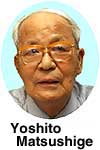(44)How many photographs were taken on the day of the atomic bombing in Hiroshima?
How many photos were taken on August 6, the day the atomic bomb was dropped?
35 photos have been confirmed
I imagine you have seen, in books or at Hiroshima Peace Memorial Museum, photos of the horrific scenes that occurred after the atomic bomb was dropped. Amid the chaos, exactly how many photos were taken?
I first spoke to Masami Nishimoto, a senior staff writer at the Chugoku Shimbun who has covered issues related to the atomic bombing for many years. He told me that, so far, 35 photos have been confirmed, a finding based on the research of the late Michio Ide, a photographer who was part of the materials research group within Hiroshima Peace Memorial Museum. The curator of the museum, Hiroaki Ochiba, confirmed that "As far as we know, this figure is correct."
Some negatives are missing

The 35 photos consist of these images: 4 photos of the burning city, 5 photos of wounded residents, 1 photo of a truck transporting victims, and 25 photos of the mushroom cloud. For 29 of these photos, the negatives or prints are preserved in Peace Memorial Museum or by newspaper companies. The negatives or prints for the remaining 6 photos, though these images once appeared in print, cannot be located.

|
| East of the Miyuki Bridge, a police officer fills out casualty certificates. (Photo by Mr. Matsushige) |
The five photos which depict the immediate aftermath of the bombing were taken by Yoshito Matsushige, a photographer for the Chugoku Shimbun who was working for the Chugoku Military District Headquarters during the war. (Mr. Matsushige passed away in 2005 at the age of 92.) On the morning of August 6, when the atomic bomb was dropped, he was at home in the southern part of the city. He took two photos at the west end of Miyuki Bridge around 11:00 a.m. and two more photos at the barbershop he ran from his home at around 2:00 p.m. He then returned to Miyuki Bridge and took one more photo of a police officer writing out casualty certificates to victims of the disaster.
In an interview with the Chugoku Shimbun in August 2001, Mr. Matsushige recalled: "When I was looking through the viewfinder, the wounded people all around were staring at me and that made it hard to take photos." He felt a mission, though, to record the event and so he went ahead and clicked the shutter. "No one else was able to take photos except for me," he said. At the same time, tears clouded his viewfinder.
Nabuhiko Kodaira, 89, now lives in Tokyo. An army captain at the field shipping workshop at the time of the bombing, he took photos of the mushroom cloud from Kanawa Island, about 6 kilometers from the hypocenter.
Just after the bomb's flash, he heard a huge boom and left the building to find a pink mushroom cloud forming in the sky. By the time he had retrieved his camera from his dormitory room, the cloud turned into a great column of smoke and its color changed to black and white. While the negatives have remained in his possession, he has provided Peace Memorial Museum with prints of his photos.
All photos had been kept by individuals
The existing photos were those kept by individuals. Mr. Nishimoto explained that "The government and media were so intimidated by the occupying Allied Forces that they weren't able to protect their prints and negatives." For example, Juzo Mizuno, a photographer for the Chunichi Shimbun newspaper who died in 2005 at the age of 90, reportedly said that he took 72 photos of the A-bomb Dome and other scenes of the destruction on August 9, three days after the bombing. Although some of these images appeared in his newspaper on August 14, after Japan's surrender, the company ordered him to burn both his prints and negatives.
It is still not certain, though, that all 35 photos were actually taken on the day of the bombing. Even now, the media sometimes proclaims the finding of new "never-before-seen photos."
In 2008, a history professor at the University of California claimed to have discovered new photos of the atomic bombing of Hiroshima, but these photos turned out to be images of the Great Kanto Earthquake of 1923. The major French newspaper, Le Monde, was forced to print a retraction as a result of this incident.
The vague surroundings in these photos, as well as the lack of notation on them, probably contributed to this error. (Kensuke Murashima, Staff Writer)
- Chugoku Military District Headquarters
Established in June 1945 by the Japanese military on the grounds of Hiroshima Castle. The commander, officers, and communication staff worked there to deliver warnings and air-raid alerts to key sites in the Chugoku region and communicated with units in other areas through the use of coded messages.
- The field shipping workshop
Part of the Army Shipping Headquarters, this section was charged with refitting transport ships that carried soldiers and supplies from Hiroshima into battle. On Kanawa Island, the workshop repaired the bodies of ships and communication devices.